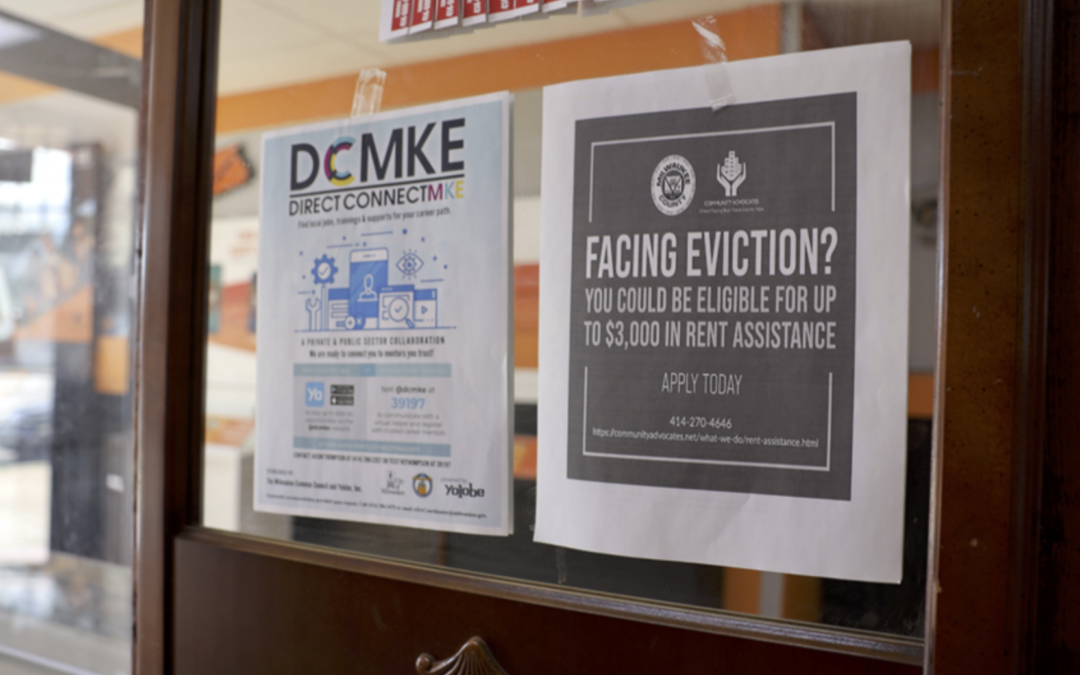
Evictions Damage Public Health. The CDC Aims to Curb Them ― For Now.
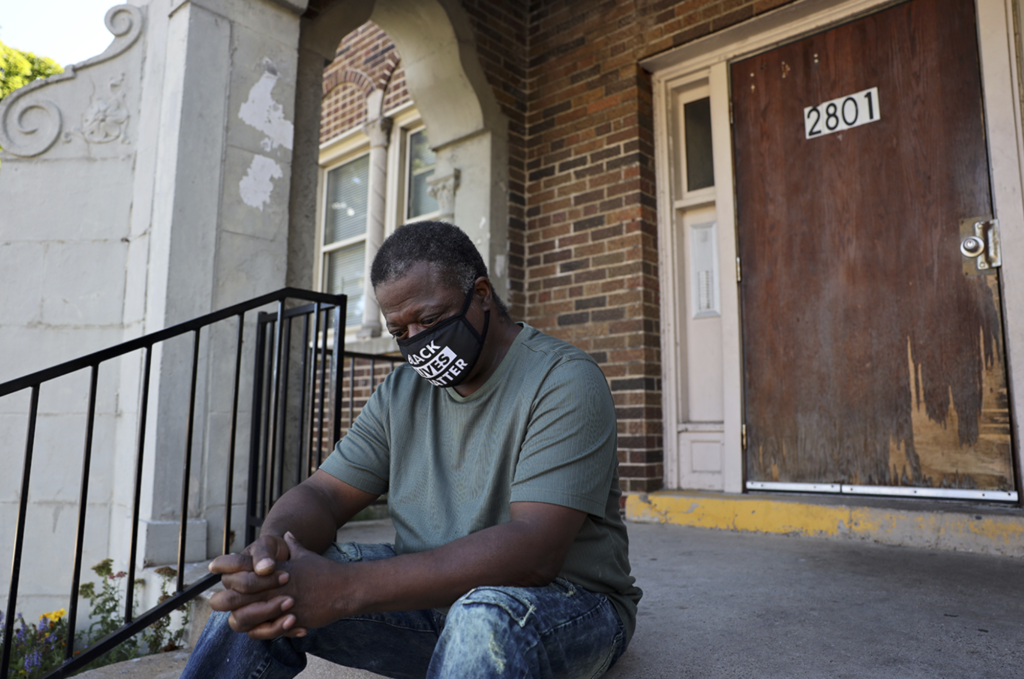
Robert Pettigrew has a mass on his lung that makes him more suscpetible to contracting COVID-19, so he had to give up his job at Motel 6 when the pandemic struck. The loss in income meant that his family had trouble paying the $600-a-month rent on their two-bedroom apartment in Milwaukee, and were served an eviction notice by their landlord after a statewide eviction moratorium expired in May. (Coburn Dukehart/Wisconsin Watch)
In August, Robert Pettigrew was working a series of odd jobs. While washing the windows of a cellphone store he saw a sign, one that he believes the “good Lord” placed there for him.
“Facing eviction?” the sign read. “You could be eligible for up to $3,000 in rent assistance. Apply today.”
It seemed a hopeful omen after a series of financial and health blows. In March, Pettigrew, 52, learned he has an invasive mass on his lung that restricts his breathing. His doctor told him his condition puts him at high risk of developing deadly complications from COVID-19 and advised him to stop working as a night auditor at a Motel 6, where he manned the front desk. Reluctantly, he had to leave that job and start piecing together other work.
With pay coming in less steadily, Pettigrew and his wife, Stephanie, fell behind on the rent. Eventually, they were many months late, and the couple’s landlord filed to evict them.
Then Pettigrew saw the rental assistance sign.
“There were nights I would lay in bed and my wife would be asleep, and all I could do was say, ‘God, you need to help me. We need you,’” Pettigrew said. “And here he came. He showed himself to us.”
As many as 40 million Americans faced a looming eviction risk in August, according to a report authored by 10 national housing and eviction experts. The Centers for Disease Control and Prevention cited that estimate in early September when it ordered an unprecedented, nationwide eviction moratorium through the end of 2020.
That move — a moratorium from the country’s top public health agency — spotlights a message experts have preached for years without prompting much policy action: Housing stability and health are intertwined.
The CDC is now citing stable housing as a vital tool to control the coronavirus, which has killed more than 200,000 Americans. Home is where people isolate themselves to avoid transmitting the virus or becoming infected. When local governments issue stay-at-home orders in the name of public health, they presume that residents have a home. For people who have the virus, home is often where they recover from COVID-19’s fever, chills and dry cough — in lieu of, or after, a hospital stay.
But the moratorium is not automatic. Renters have to submit a declaration form to their landlord, agreeing to a series of statements under threat of perjury, including “my housing provider may require payment in full for all payments not made prior to and during the temporary halt, and failure to pay may make me subject to eviction pursuant to state and local laws.”
Confusion surrounding the CDC’s order means some tenants are still being ordered to leave their homes.
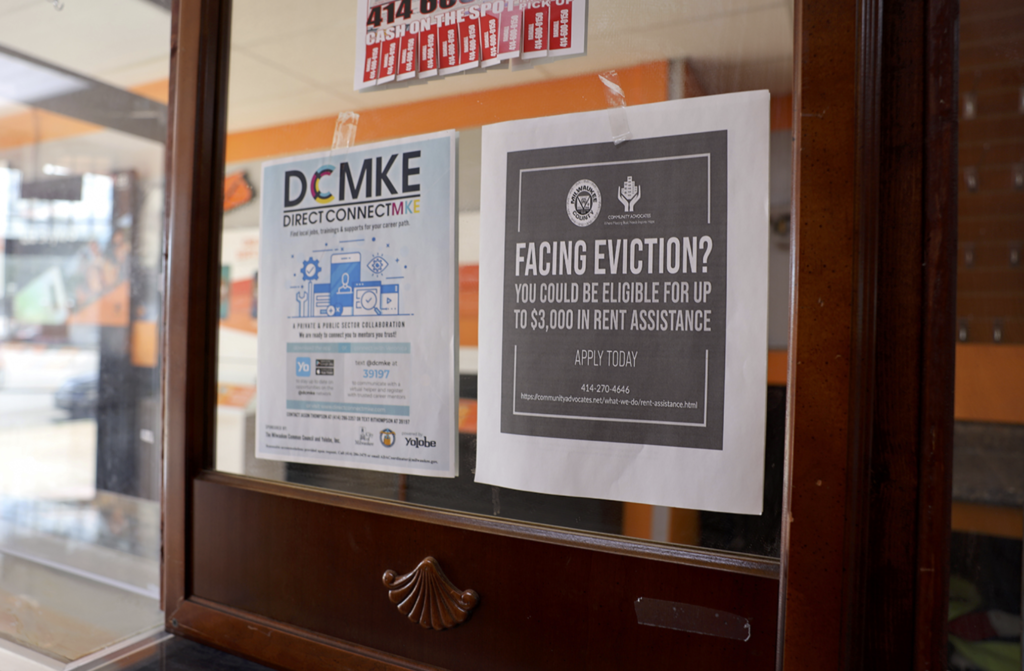
A sign inside a Boost Mobile store in Milwaukee prompted Robert Pettigrew to call Community Advocates to ask for help paying rent on the apartment he shares with his wife, daughter and grandson. The Centers for Disease Control and Prevention said stable housing is vital to controlling the coronavirus pandemic.(COBURN DUKEHART/WISCONSIN WATCH)
Princeton University is tracking eviction filings in 17 U.S. cities during the pandemic. As of Sept. 19, landlords in those cities have filed for more than 50,000 evictions since March 15. The tally includes about 11,900 in Houston, 10,900 in Phoenix and 4,100 in Milwaukee.
It’s an incomplete snapshot that excludes some major American cities such as Indianapolis, where local housing advocates said court cases are difficult to track, but landlords have sought to evict thousands of renters.
Children raised in unstable housing are more prone to hospitalization than those with stable housing. Homelessness is associated with delayed childhood development, and mothers in families that lose homes to eviction show higher rates of depression and other health challenges.
Mounting research illustrates that even the threat of eviction can exact a physical and mental toll from tenants.
Nicole MacMillan, 38, lost her job managing vacation rentals in Fort Myers, Florida, in March when the pandemic shut down businesses. Later, she also lost the apartment where she had been living with her two children.
“I actually contacted a doctor, because I thought, mentally, I can’t handle this anymore,” MacMillan said. “I don’t know what I’m going to do or where I’m going to go. And maybe some medication can help me for a little bit.”
But the doctor she reached out to wasn’t accepting new patients.
With few options, MacMillan moved north to live with her grandparents in Grayslake, Illinois. Her children are staying with their fathers while she gets back on her feet. She recently started driving for Uber Eats in the Chicagoland area.
“I need a home for my kids again,” MacMillan said, fighting back tears. The pandemic “has ripped my whole life apart.”
Searching for Assistance to Stay at Home
That store window sign? It directed Pettigrew to Community Advocates, a Milwaukee nonprofit that received $7 million in federal pandemic stimulus funds to help administer a local rental aid program. More than 3,800 applications for assistance have flooded the agency, said Deborah Heffner, its housing strategy director, while tens of thousands more applications have flowed to a separate agency administering the state’s rental relief program in Milwaukee.
Persistence helped the Pettigrews break through the backlog.
“I blew their phone up,” said Stephanie Pettigrew, with a smile.
She qualifies for federal Social Security Disability Insurance, which sends her $400 to $900 in monthly assistance. That income has become increasingly vital since March when Robert left his motel job.
He has since pursued a host of odd jobs to keep food on the table — such as the window-washing he was doing when he saw the rental assistance sign — work where he can limit his exposure to the virus. He brings home $40 on a good day, he said, $10 on a bad one. Before they qualified for rent assistance, February had been the last time the Pettigrews could fully pay their $600 monthly rent bill.
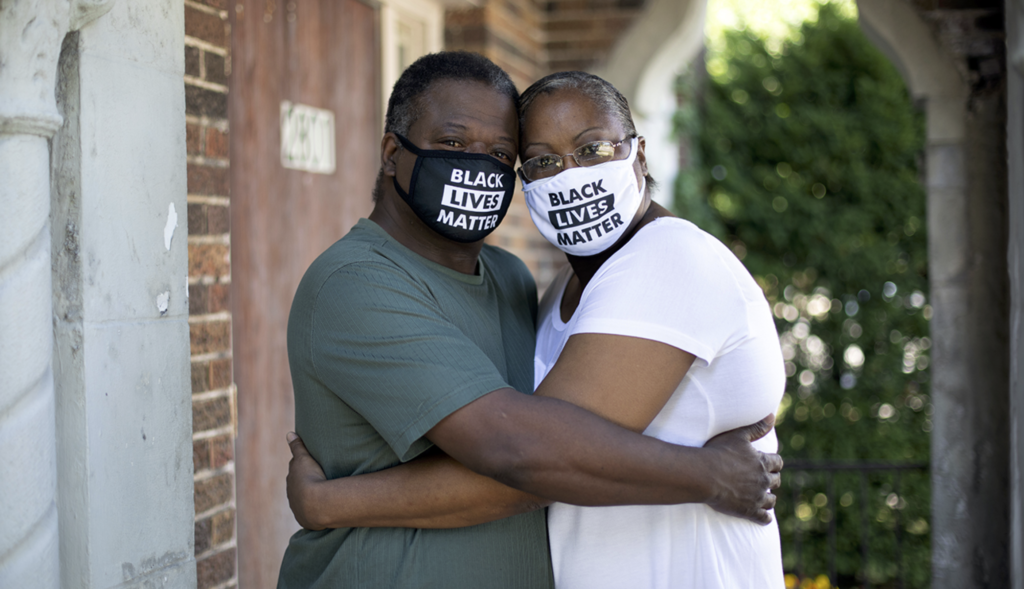
Robert and Stephanie Pettigrew embrace outside their two-bedroom rental apartment in Milwaukee on Sept. 4. In August, local group Community Advocates covered more than $4,700 in the Pettigrews’ rental payments, late charges, utility bills and court fees, and is now helping them look for a more affordable place to live.(COBURN DUKEHART/WISCONSIN WATCH)
Just as their finances tightened and their housing situation became less stable, the couple welcomed more family members. Heavenly, Robert’s adult daughter, arrived in May from St. Louis after the child care center where she worked shut down because of concerns over the coronavirus. She brought along her 3-year-old son.
Through its order, the CDC hopes to curtail evictions, which can add family members and friends to already stressed households. The federal order notes that “household contacts are estimated to be 6 times more likely to become infected by [a person with] COVID-19 than other close contacts.”
“That’s where that couch surfing issue comes up — people going from place to place every few nights, not trying to burden anybody in particular, but possibly at risk of spreading around the risk of coronavirus,” said Andrew Bradley of Prosperity Indiana, a nonprofit focusing on community development.
The Pettigrews’ Milwaukee apartment — a kitchen, a front room, two bedrooms and one bathroom — is tight for the three generations now sharing it.
“But it’s our home,” Robert said. “We’ve got a roof over our head. I can’t complain.”
Housing Loss Hits Black and Latino Communities
A U.S. Census Bureau survey conducted before the federal eviction moratorium was announced found that 5.5 million of American adults feared they were either somewhat or very likely to face eviction or foreclosure in the next two months.
State and local governments nationwide are offering a patchwork of help for those people.
In Massachusetts, the governor extended the state’s pause on evictions and foreclosures until Oct. 17. Landlords are challenging that move both in state and federal court, but both courts have let the ban stand while the lawsuits proceed.
“Access to stable housing is a crucial component of containing COVID-19 for every citizen of Massachusetts,” Judge Paul Wilson wrote in a state court ruling. “The balance of harms and the public interest favor upholding the law to protect the public health and economic well-being of tenants and the public in general during this health and economic emergency.”
The cases from Massachusetts may offer a glimpse of how federal challenges to the CDC order could play out.
By contrast, in Wisconsin, Gov. Tony Evers was one of the first governors to lift a state moratorium on evictions during the pandemic — thereby enabling about 8,000 eviction filings from late May to early September, according to a search of an online database of Wisconsin circuit courts.
Milwaukee, Wisconsin’s most populous city, has seen nearly half of those filings, which have largely hit the city’s Black-majority neighborhoods, according to an Eviction Lab analysis.
In other states, housing advocates note similar disparities.
“Poor neighborhoods, neighborhoods of color, have higher rates of asthma and blood pressure — which, of course, are all health issues that the COVID pandemic is then being impacted by,” said Amy Nelson, executive director of the Fair Housing Center of Central Indiana.
“This deadly virus is killing people disproportionately in Black and brown communities at alarming rates,” said Dee Ross, founder of the Indianapolis Tenants Rights Union. “And disproportionately, Black and brown people are the ones being evicted at the highest rate in Indiana.”
Across the country, officials at various levels of government have set aside millions in federal pandemic aid for housing assistance for struggling renters and homeowners. That includes $240 million earmarked in Florida, between state and county governments, $100 million in Los Angeles County and $18 million in Mississippi.
In Wisconsin, residents report that a range of barriers — from application backlogs to onerous paperwork requirements — have limited their access to aid.
In Indiana, more than 36,000 people applied for that state’s $40 million rental assistance program before the application deadline. Marion County, home to Indianapolis, had a separate $25 million program, but it cut off applications after just three days because of overwhelming demand. About 25,000 people sat on the county’s waiting list in late August.
Of that massive need, Bradley, who works in economic development in Indiana, said: “We’re not confident that the people who need the help most even know about the program — that there’s been enough proactive outreach to get to the households that are most impacted.”
After Milwaukeean Robert Pettigrew saw that sign in the store window and reached out to the nonprofit Community Advocates, the group covered more than $4,700 of the Pettigrews’ rental payments, late charges, utility bills and court fees. The nonprofit also referred the couple to a pro-bono lawyer, who helped seal their eviction case — that means it can’t hurt the Pettigrews’ ability to rent in the future, and ensures the family will have housing at least through September. The CDC moratorium has added to that security.
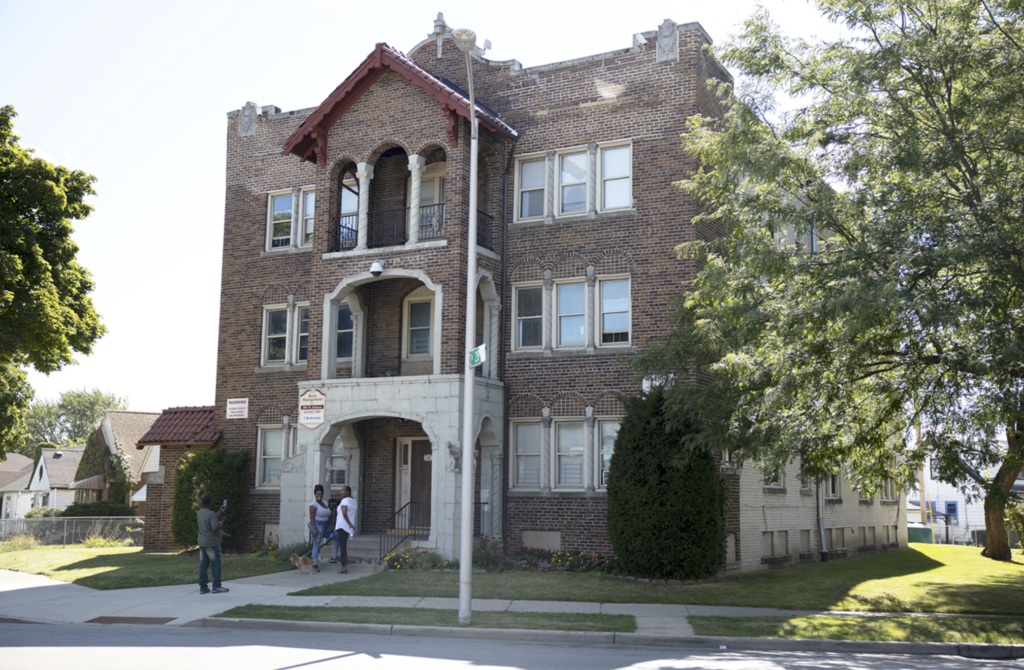
Heavenly Pettigrew and her 3-year-old son moved in with her parents in May after the St. Louis child care center where she’d been working closed because of the pandemic. The two-bedroom, one-bath apartment is tight for three generations, said Heavenly’s father, Robert, “but it’s our home.”(COBURN DUKEHART/WISCONSIN WATCH)
The federal eviction moratorium, if it withstands legal challenges from housing industry groups, “buys critical time” for renters to find assistance through the year’s end, said Emily Benfer, founding director of the Wake Forest Law Health Justice Clinic.
“It’s protecting 30 to 40 million adults and children from eviction and the downward spiral that it causes in long-term, poor health outcomes,” she said.
Doctor: Evictions Akin to ‘Toxic Exposure’
Megan Sandel, a pediatrician at Boston Medical Center, said at least a third of the 14,000 families with children that seek treatment at her medical center have fallen behind on their rent, a figure mirrored in national reports.
Hospital officials worry that evictions during the pandemic will trigger a surge of homeless patients — and patients who lack homes are more challenging and expensive to treat. One study from 2016 found that stable housing reduced Medicaid spending by 12% — and not because members stopped going to the doctor. Primary care use increased 20%, while more expensive emergency room visits dropped by 18%.
A year ago, Boston Medical Center and two area hospitals collaborated to invest $3 million in emergency housing assistance as community organizing focused on affordable housing policies and development. Now the hospitals are looking for additional emergency funds, trying to boost legal resources to prevent evictions and work more closely with public housing authorities and state rental assistance programs.
“We are a safety-net hospital. We don’t have unlimited resources,” Sandel said. “But being able to avert an eviction is like avoiding a toxic exposure.”
Sandel said the real remedy for avoiding an eviction crisis is to offer Americans substantially more emergency rental assistance, along the lines of the $100 billion included in a package proposed by House Democrats in May and dubbed the Heroes Act. Boston Medical Center is among the 26 health care associations and systems that signed a letter urging congressional leaders to agree on rental and homeless assistance as well as a national moratorium on evictions for the entire pandemic.
“Without action from Congress, we are going to see a tsunami of evictions,” the letter stated, “and its fallout will directly impact the health care system and harm the health of families and individuals for years to come.”
Groups representing landlords urge passage of rental assistance, too, although some oppose the CDC order. They point out that property owners must pay bills as well and may lose apartments where renters can’t or won’t pay.
In Milwaukee, Community Advocates is helping the Pettigrews look for a more affordable apartment. Robert Pettigrew continues attending doctors’ appointments for his lungs, searching for safe work. He looks to the future with a sense of resolve — and a request that no one pity his family.
“Life just kicks you in the butt sometimes,” he said. “But I’m the type of person — I’m gonna kick life’s ass back.”
For this story, NPR and KHN partnered with the investigative journalism site Wisconsin Watch, Side Effects Public Media, Wisconsin Public Radio and WBUR.
Subscribe to KHN’s free Morning Briefing.

